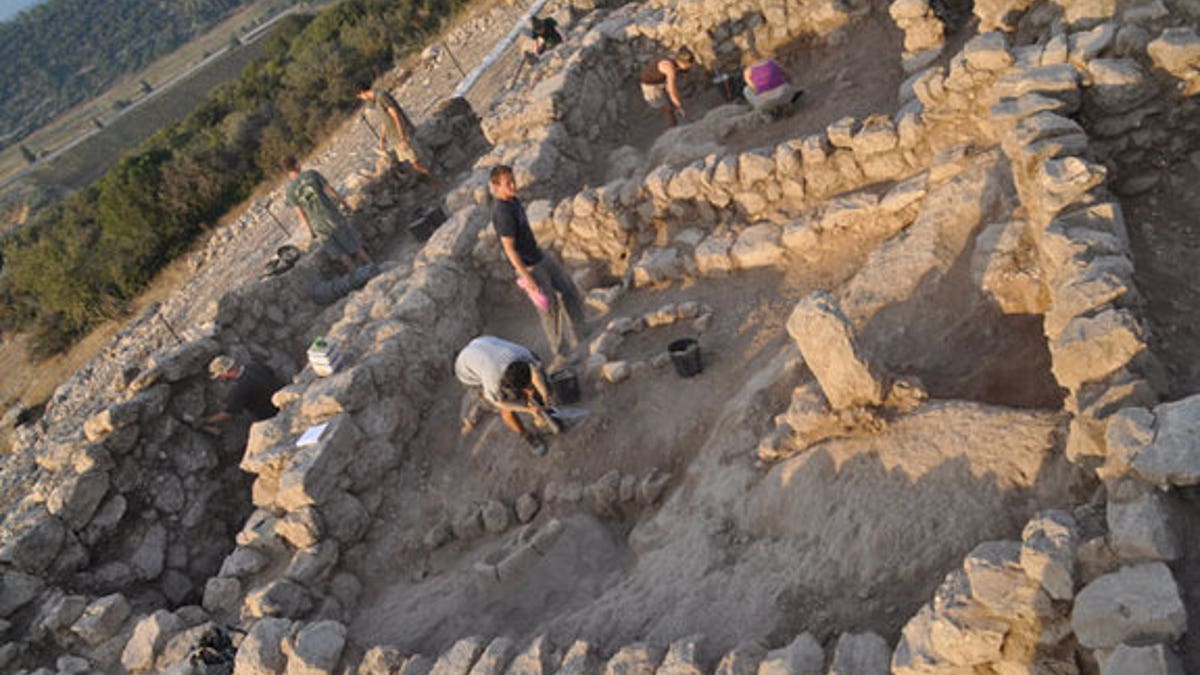
The excavation of a shrine in the 3,000-year-old city of Khirbet Qeiyafa near Jerusalem. (Hebrew University of Jerusalem)
For the first time, archaeologists have uncovered shrines from the time of the early Biblical kings in the Holy Land, providing the earliest evidence of a cult, they say.
Excavation within the remains of the roughly 3,000-year-old fortified city of Khirbet Qeiyafa, located about 19 miles (30 kilometers) southwest of Jerusalem, have revealed three large rooms used as shrines, along with artifacts, including tools, pottery and objects, such as alters associated with worship.
The three shrines were part of larger building complexes, and the artifacts included five standing stones, two basalt altars, two pottery libation vessels and two portable shrines, one made of pottery, the other of stone. The portable shrines are boxes shaped like temples.
The shrines themselves reflect an architectural style dating back as early as the time of King David (of the biblical David and Goliath story), providing the first physical evidence of a cult in the time of King David, according to an announcement by Yosef Garfinkel, an archaeologist at Hebrew University of Jerusalem. [Religious Worship: Top 10 Cults]
The research is presented in the book, "Footsteps of King David in the Valley of Elah" (Yedioth Ahronoth, 2012).
Radiocarbon dating on burnt olive pits found in the ancient city of Khirbet Qeiyafa indicate it existed between 1020 B.C. and 980 B.C., before being violently destroyed.
According to Biblical tradition, the ancient Isrealites' belief in one God and their ban on human and animal figures set them apart from their neighbors. However, it hasn't been clear when these distinct practices arose.
The discoveries offer a clue to the timing, since they contain none of the human or animal figurines common at other sites. No bones from pigs showed up here or elsewhere in the city.
"This suggests that the population of Khirbet Qeiyafa observed two Biblical bans — on pork and on graven images — and thus practiced a different cult than that of the Canaanites or the Philistines," Garfinkel said in a press release issued by the university. The discoveries also offer support for the Biblical depiction of King David, he said.
Garfinkel suggests some of the features and styles of the structures appear analogous to those described in the Bible. For instance, one of the shrines, the clay one, is decorated with an elaborate façade that includes two guardian lions, two pillars, folded textile and three birds standing on the roof. The two pillars are suggestive, he said, of Yachin and Boaz described in the Bible as belonging to Solomon's Temple.
The announcement was met with some skepticism from scientists such as Aren Maeir of Bar-Ilan University, who has studied the ruins of the nearby Philistine city of Gath. Maeir told the Times of Israel the new finds don't conclusively prove the site was inhabited by Israelites, and that the images of lions and birds also undercut that no animal or human figures were found.
"There's no question that this is a very important site, but what exactly it was — there is still disagreement about that," Maeir said in the Times of Israel, adding that the finding doesn't add dramatic new evidence to the broader debate over whether the Bible is an historical record of events, largely mythical or a mix between fact and fiction.
Copyright 2012 LiveScience, a TechMediaNetwork company. All rights reserved. This material may not be published, broadcast, rewritten or redistributed.




















